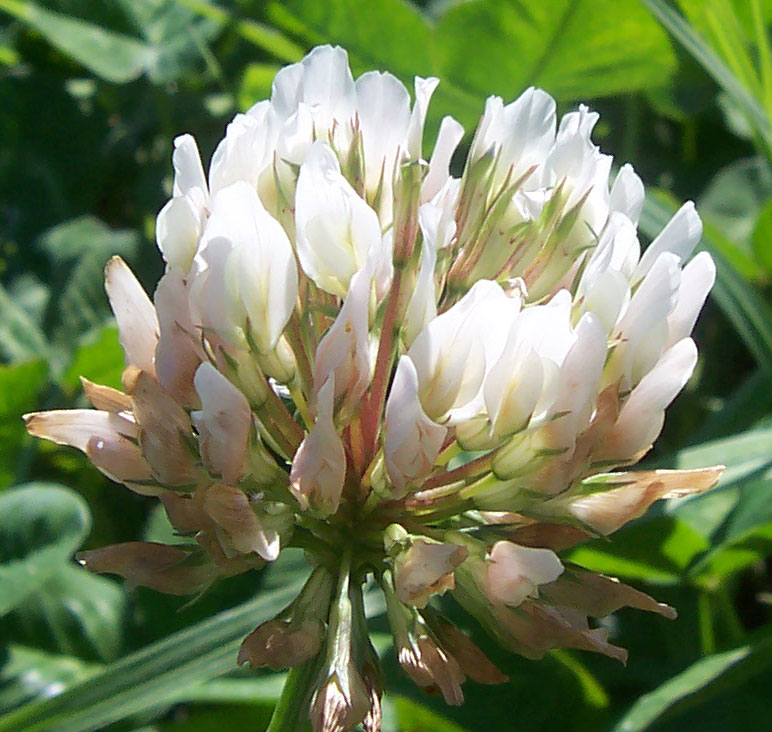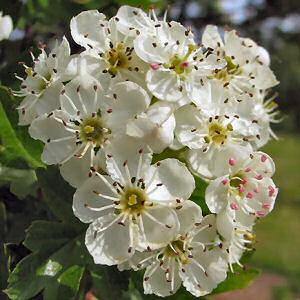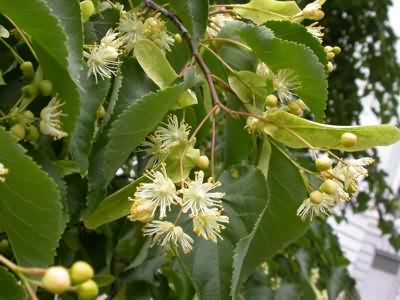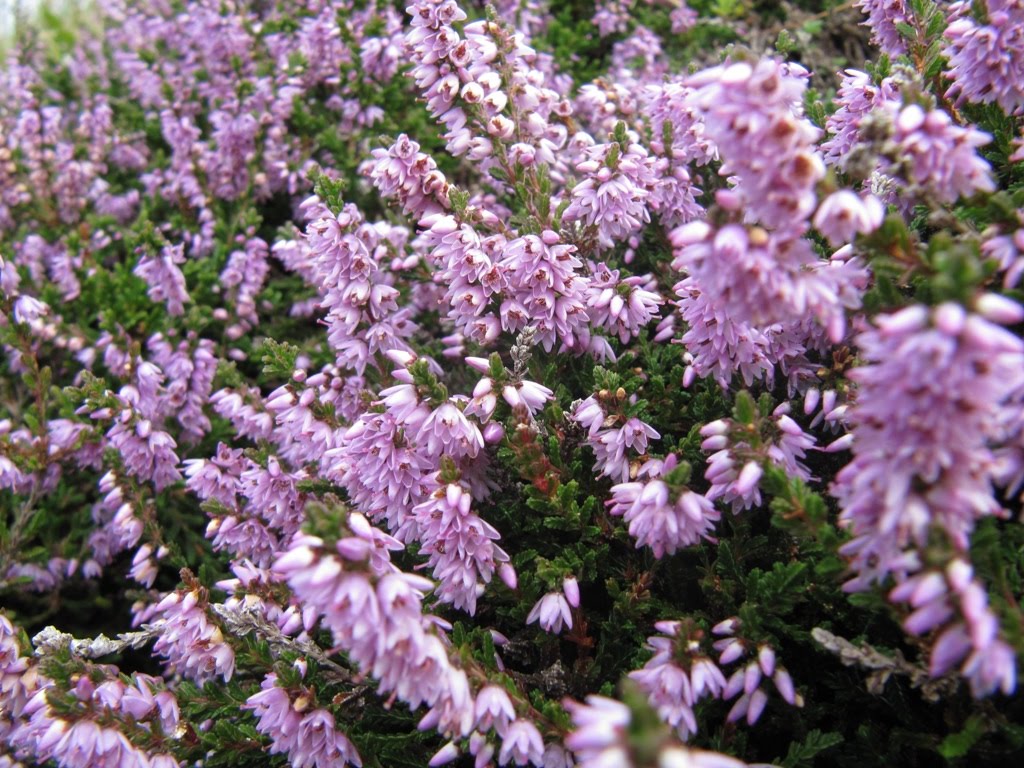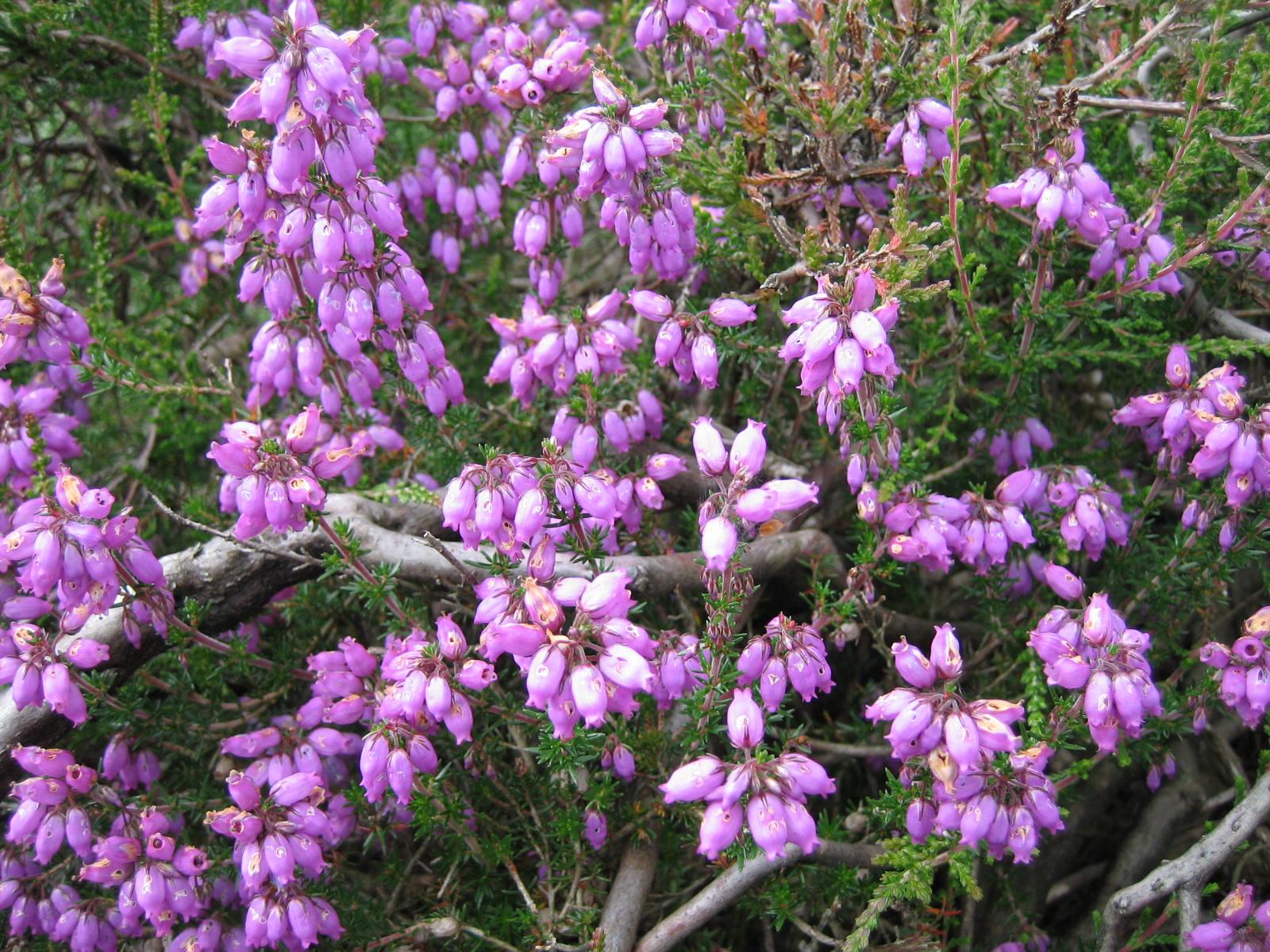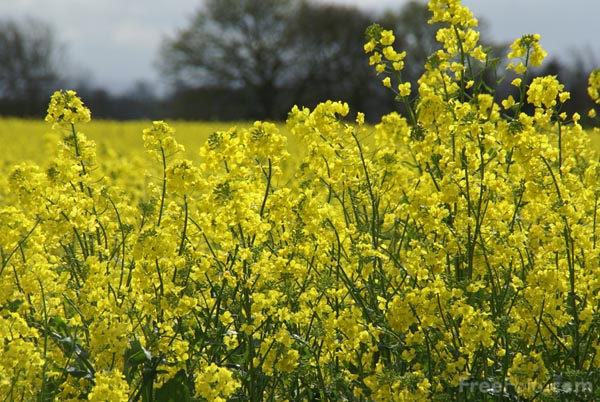Bee Flora in Ireland
Introduction
Ireland has a narrower range of native plant species than most neighbouring countries. The main reason is its earlier separation from the European mainland by the rise of post-glacial oceans.
The climate is cool, temperate and oceanic, but warmer than normal for its high latitude due to the influence of the Gulf Stream current. Rainfall averages 115cm over 220 days evenly distributed throughout the year, with less in the East and more in the West and on mountains.
Average wind-speed is very high; this and the frequent rainfall give a disproportionate importance in the Irish bee flora to plants with a long flowering period and pendent flowers whose nectar is not diluted by rain.
The geology of the midlands is mainly Carboniferous limestone covered by limestone glacial till. The soils derived from these tend to be alkaline. Mountains, which are concentrated near the coasts, are mostly of older sedimentary, metamorphic or igneous rocks that produce acid soils.
There can be a wide range of different soil, climate and habitat types within a small area, and most bee colonies have several within foraging range
Bees collect nectar and pollen from flowers. The nectar is converted into honey, the bee’s energy producing food. The pollen supplies proteins, vitamins and minerals that are essential for growth, especially in the larval stage, and for body development and maintenance in the adult bee.
Irish beekeepers get surplus crops of honey from a small number of plants: White Clover, Blackberry, Lime, Ling heather, Bell heather, Hawthorn, Sycamore, fruit blossom (e.g. Raspberry), Oilseed rape, and Knapweed.
Some of those plants are restricted to certain localities; heather requires acid soils such as bog land or mountain areas. Other plants such as Clover, Blackberry and Hawthorn are more widespread.
Modern farming practices affect bee plants; silage cutting may reduce or almost eliminate a honey yield from Clover if the crop is cut as it starts to flower, and heavy use of nitrogenous fertilisers and/or slurry stimulates grass growth at the expense of clover.
Severe cutting of Hawthorn and Blackberry in hedges will reduce the flowers. Overgrazing of hills in past years has destroyed extensive heather sites. On the credit side the introduction of oilseed rape has benefited many beekeepers.
White Clover (Trifolium repens)
White clover is an important source of honey in Ireland and in temperate zones worldwide. After grass it is the most dominant plant found in our pastures, both as a result of natural reseeding and of its inclusion in grass seed mixtures; it has a long season of flowering, from late May until early August and each flower head consists of many individual flowers.White clover requires a soil with a pH of 6.0 to 6.5 or higher for heavy nectar secretion and in acid soils is a poor honey plant. Many areas have soils that are naturally suitable. Farmers in many other counties, by spreading ground limestone, maintain the pH level at its most productive value that fortunately suits clover also.
Clover yields best when the day temperature is between 20°C and 25°C or higher with plenty of moisture in the ground; a shallow rooted plant, it stops secreting nectar if the topsoil dries up
Under suitable climatic conditions – warm, sunny, abundant moisture in the soil – clover may yield heavily for three to four weeks. The heaviest nectar flows, depending on the season and the district, are from mid June to late July.
White clover honey varies from white to light amber in colour depending on the soil and the season. It has a mild, pleasant flavour and is the most popular honey on the market. It produces the finest sections of all honeys.
White clover pollen is common in honey but is rarely collected in the pollen baskets by the bees and the beekeeper seldom sees loads of it on the bee’s legs; it has a greenish brown colour.
Co. Wexford is the main white clover honey producing area along with Waterford and Cork on the south coast and parts of Wicklow and Dublin on the east coast. But beekeepers harvest good crops in other areas, including the valley of the three sister rivers – Barrow, Nore and Suir .
In most years the weather reduces the nectar flow in the west and north of the country but in some areas good crops are obtained.
What is the future of white clover in Irish Farming? Many farmers are now using less artificial nitrogen fertilisers. Once again they are relying more on the fixation of atmospheric nitrogen by bacteria in the root nodules of legumes such as clover.
Blackberry (Rubus fruticosus)
In many parts of Ireland Blackberry or Bramble is second only to white clover as a valuable nectar producing plant, and in cooler summers Blackberry is the main source of the surplus honey crop in most areas.
Blackberry grows freely almost everywhere irrespective of soil type, and it has a long flowering season. In low-lying southern counties it flowers from mid June to early August, overlapping the clover season.
Bees work both plants at the same time, resulting in a clover honey blended with some blackberry honey providing the main surplus crop. Since pure blackberry honey has what some consider an unattractive flavour, this blending masks the taste and, in fact, many people prefer the blend to pure clover honey.
The Blackberry species is highly variable – one research botanist listed over three hundred varieties in Ireland. Anyone can identify many varieties in an ordinary farm hedge – some with thorns, others thornless; flowers coloured white, pink and various shades; rounded, pointed or divided leaves; early flowering and late flowering.
This variation is an added bonus for beekeepers as it extends the flowering season and probably has varieties that maximise honey production at different temperature and moisture levels. Both increase the reliability of the Blackberry nectar flow in Ireland.
Hawthorn (Crataegus oxycantha)
Hawthorn is also called the May Bush or Whitethorn, or by its Irish name, Sceach. It flourishes in hedges everywhere except in the very acid bog-land soils. It flowers from mid-May to mid-June, depending on the weather and the locality.
Unfortunately it is a most irregular yielder of nectar even when flowering in warm sunny weather. A study in the USA in areas where the hawthorn grows abundantly but also yields irregularly, even though the weather pattern is almost uniform, failed to identify the reason.
Here when we get a heavy flow from hawthorn the weather is warm and humid; such a flow is heavy and continues sometimes for ten to fourteen days as in 1998 but often for only a few days.
Some connoisseurs of honey rate hawthorn honey as their favourite with its rich, nutty flavour. It has a very good ‘body’ or density, a dark, brownish colour and a distinctive almond aroma.
Hawthorn is also an excellent supplier of pollen and it is easy to recognise the pale white pollen loads in the bees’ pollen baskets. At the time when brood rearing is at its peak, this fresh pollen is invaluable.
The Lime (Tilia)
Lime trees, known as the Linden or Basswood in some countries and a major honey producer world-wide, are of limited value to Irish beekeepers as our summers are usually too cool.
Some avenues or small groves of lime provide extensive bee forage, and in favourable seasons local beekeepers obtain a reasonable surplus. There are several species of lime flowering from June to August but the common type found in Ireland, Tilia vulgaris, is in blossom in July.
Warm, humid nights favour nectar secretion from the lime and the flow is heavy. The nectar usually dries up by early afternoon, so to check if the bees are working the lime watch the tree in the morning..
Lime honey is extra light in colour but sometimes may have a greenish tinge, and has a sharp taste when pure.
Lime trees have one undesirable feature – honeydew. This honeydew is the secretion of insects that live on the leaves of the lime tree. Occasionally the bees collect this dark, strong-tasting liquid, spoiling the honey with which it is mixed.
Not all honeydew is unpleasant. In many European countries (e.g. Germany) the most highly sought after honey is the honeydew from conifers, and many beekeepers there rely on it for their main crop.
Ling Heather (Calluna vulgaris)
When people talk of heather honey they generally mean the honey derived from Ling heather. This honey is thixotropic: it forms a jelly and will not flow or pour except when agitated.
Ling heather grows extensively in the drier parts of peat bogs and on mountains and hillsides where the soil is acidic. It flowers from early August to late September but nectar secretion is confined to a short spell, often only four or five days.
The actual date of maximum nectar flow varies from year to year and it can occur anytime when the plant is in flower. Some years the Ling yields little or nothing even though the weather is apparently suitable, while in other similar years it yields copiously. Young heather yields better than old bushy plants.
Heather honey has its own particular flavour unlike that of any other honey, and is a favourite with many people. It may vary in colour from light to dark brown. The demand for heather honey far outstrips supply and it fetches a premium price. As it is difficult to extract many beekeepers prefer to produce heather honey in sections.
Ling flowers so late in the season, when the other major nectar producing plants have finished flowering, that many beekeepers move their bees to heather areas in August.
While they may not harvest a surplus crop every year, at least the brood chamber is usually full of stores for the winter. Unless bees are confined to the hive for a long spell, which is unusual in Ireland, heather honey is suitable for winter food.
The traditional advice to those moving bees to the heather is – go early, early in the morning, early in August and come home late, late in the evening, late in September.
Pure heather honey is rarely produced in Ireland as bees work other plants that flower nearby at the same time, notably Knapweed and Scabious. Both are valuable nectar plants and often the honey from these makes up a large percentage of the so-called heather honey crop
Bell Heather (Erica cinerea)
Bell Heather is a valuable nectar producing plant providing a honey that flows and is easy to extract. The honey has a port wine colour and a heather-like flavour.
Bell Heather flowers during July but may continue into August and overlap with ling. Its flowers are a rich deep purple colour and very attractive. When people talk of the heather clad hills and bogs they are referring to bell heather flowers as Ling has inconspicuous flowers only noticed close up. Bell Heather grows in almost the same environment as Ling.
Beekeepers in North-eastern Ireland move their bees to the Mourne Mountains in July to harvest a rewarding crop from the bell heather. The Mournes are outstanding for this honey crop; seemingly the soil is ideal.
When people plant heather in their gardens they are planting varieties bred or selected from heather species; they are very attractive to bees and provide valuable nectar and pollen, especially the spring or late autumn flowering varieties. While most of the garden heaths require an acid soil some will grow in alkaline conditions and nurseries and garden centres will advise on these plants.
Oil Seed Rape (Brassica napus)
Oilseed Rape, introduced into Ireland as a ‘break’ crop to facilitate crop rotation on tillage farms, soon became a valuable cash crop resulting in more being grown.
Oilseed rape is a very good nectar producer, and with its abundant flowers opening continuously over several weeks a surplus of honey is stored rapidly. As rape honey granulates very quickly it must be extracted immediately after removal from the hive.
Some people consider oilseed rape honey as having a bland taste, but when blended with clover or similar mild honey the resulting flavour is attractive.
Minor Plants
Fuchsia (F. magellanica) was introduced from its native South America and is now widespread in the hedges of western Ireland. The crimson and purple flowers are produced from early summer to the first frosts, and as they hang down their nectar is less diluted by rain.
Rosebay Willowherb (Epilobium angustifolium) is not well-known in Ireland yet. It is first to bloom after a forest fire, hence its American name – Fireweed. Its tall flower-spikes carry a long succession of small shocking-pink trumpets that produce copious nectar. It is increasing in numbers, and likely to become a locally important bee plant as Irish forests planted in the 1950s mature and are clear-felled. The honey is water-white and insipid, but useful for blending with rank-flavoured honeys such as from Ragwort (Senecio jacobaea)
Ragwort is widespread throughout Ireland on the lighter drier soils, and its pollen is found in most samples of Irish honey.
Dandelion (Taraxacum officinale) is a valuable source of both nectar and pollen in spring and early summer. Its exceptionally long flowering season and its ability to grow almost anywhere add to its value. The flowers open only in sunshine and this protects the nectar and pollen from damage by rain or frost. In favourable seasons a little surplus dandelion honey is stored and is easily identified by its very deep yellow wax capping.
Willow or Sally (Salix spp.)is found practically everywhere but especially in river valleys and where the soil is wet. There are
numerous species flowering from February to May. Pollen is produced freely and as it is rich in essential amino acids it is of great value to bee colonies for spring build-up. Most willows yield nectar also.
Since willows root freely from cuttings beekeepers should propagate the best strains (e.g. Pussy Foot or Goat Willow), planting them in waste ground.
Beekeepers in the midlands find Knapweed(Centaurea nigra, also called Blackheads or Hardheads) a very good nectar producer in early autumn overlapping the ling heather flow.
Sycamore (Acer pseudoplatanus) is a member of the maple family notable for the high sugar content of the sap. This rich sap results in high yields of nectar from the sycamore in May when weather is suitable but bees use most of it to feed their brood and surpluses are rare.
Horse Chestnut also flowers in May and is another valuable source of nectar and pollen; the pollen is a distinctive brick-red colour.
Ivy (Hedera helix) is excellent for topping up winter stores. It flowers from September to the first hard frost and is a copious producer of pollen and very concentrated nectar. It is one of the most reliable bee plants in Ireland and there is always at least a fortnight of suitable weather while the ivy is in flower.
There are many other plants of minor importance, yielding nectar or pollen or both and all helping to provide food for bees. These include Thistles, Trefoils (especially Bird’s Foot), Ragwort, Sage, Scabious, Butterbur and Gorse.
Fruit
Apple (Malus pumila)
Apples are the most widely grown fruit in Ireland and, depending on the season, may start flowering as early as mid-April or as late as mid-May and continue in flower for three to four weeks. It is a valuable source of nectar and pollen for this period of maximum brood rearing but rarely is a surplus honey crop obtained.
Raspberry (Rubus idaeus)
This is an excellent yielder of both nectar and pollen. Where a large acreage is grown, beekeepers who provide colonies for pollination may get a surplus of light coloured honey.
Raspberry flowers hang downward and hence the nectar is protected from rain; often the bees are seen visiting the flowers in light rain when other flowers are ignored. Raspberries flower in June in what some beekeepers call the ‘hungry gap’ before the clover/blackberry flow.
Other Fruit
Other fruits are of minor importance. Blackcurrant(Ribes nigrum) is a source of nectar and pollen; it flowers in April. Gooseberry (Ribes grossularia) flowers earlier than the blackcurrant and is a minor Spring food source. Strawberry (Fragarea vesca) iis a useful pollen plant but a poor yielder of nectar.
Bees are essential for pollination of fruit crops. While some cultivars will produce partial crops by self-pollination others are self-sterile and must have insect pollination to fertilise them; two examples are Bramley Seedling apple and Conference pear.
Planting for Bees
If you want to enjoy the sight and sound of bees foraging in your garden, or to help support your local bees by providing food for them, here are some suggestions.
Bees very rarely sting when foraging for nectar and pollen: they are much too busy making honey while the sun shines to bother with people. Growing a few more bee-friendly plants is not likely to increase the risk of stings.
Not all flowers have food for bees. ‘Double’ flowers have extra rows of petals instead of nectaries and stamens, and so produce little or no nectar or pollen. Many flowering cherry trees are double-flowered.
The most valuable plants for bees are those that flower in late autumn, winter and early spring, includingLaurustinus (Viburnun tinus) and the winter heath (Erica carnea) ‘Springwood White’. Bees use mild periods to forage for whatever nectar and pollen is available, and even small amounts of fresh supplies make a big difference to them then. In high summer there is so much nectar and pollen available everywhere that a little more doesn’t matter as much.
The nectar in pendent (downward-hanging) flowers is not diluted by our frequent rain, as can happen with open-shaped flowers. Raspberry, Fuchsia and Snowberry are more valuable because of this.
Plants with a long flowering period, such as Potentilla, Fuchsia and Laurustinus are more valuable to bees. In a spell of poor weather when they cannot leave the hive, bees could completely miss a short flowering period.
Bees prefer to forage on flowers in full sun, so plant them where they will get full sun or at least a few hours’ sun each day.
Large blocks of the one plant are more attractive to bees than ‘one each of everything’.
Shrubs generally produce more forage for bees than herbaceous plants, and trees more than any.
Don’t forget climbers: the smaller your garden the more wall and fence space it has per square metre of ground.
Never plant when the soil is sodden or frozen. Dig a hole bigger than the plant’s roots, break up the bottom and fill back around the roots with the best soil mixed with some garden compost.
Don’t let plants raised in peat-based compost dry out for the first year: the peat will shrink and tear out the new roots from the surrounding soil. A mulch of compost around the base of the plant helps keep it moist, but keep it away from the stem.
What to Plant
Trees:
Willow, Fruit trees (various) Holly, Lime, Sycamore.
Spring bulbs:
Bluebell, Chinodoxa, Crocus (yellow forms may be more attractive to bees than white or purple), Muscari (Grape Hyacinth) Scilla, Snowdrop.
Shrubs:
Berberis, Box, Brachyglottis ‘Sunshine’,Buddleja globosa (Orange Ball Tree),Chaenomeles (Flowering Quince), Cotoneaster horizontalis (Fishbone Plant), Escallonia, Flowering Currant, Fuchsia, Helianthemum, Laurustinus (Viburnun tinus), Lavender,Potentilla, Pyracantha, Rosemary, Snowberry, Staghorn Sumach (Rhus typhina), Winter heath (Erica carnea ‘Springwood White’),
Annuals & Biennials:
Alyssum, Borage, Cosmos, Forget-me-not,Limnanthes (Poached-egg plant) Mignonette, Wallflower.
Perennials:
Aster, Aubretia, Catmint, hardyGeraniums, kitchen herbs (most), Phormium,Salvia x superba
Climbers:
Clematis Montana, Hydrangea petiolaris, Ivy, Virginia Creeper
James J. Doran (RIP) and Peter Whyte

